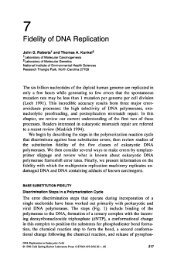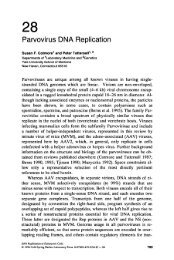Chapter 36: DNA Replication in Xenopus (PDF)
Chapter 36: DNA Replication in Xenopus (PDF)
Chapter 36: DNA Replication in Xenopus (PDF)
You also want an ePaper? Increase the reach of your titles
YUMPU automatically turns print PDFs into web optimized ePapers that Google loves.
976 J.J. Blow and J.P.J. Chong<br />
Figure 2 provides an explanation of these results (Blow and Laskey<br />
1988; Blow 1993; Chong et al. 1996). An essential replication factor<br />
called replication licens<strong>in</strong>g factor (RLF) b<strong>in</strong>ds <strong>DNA</strong> dur<strong>in</strong>g late mitosis<br />
before nuclear assembly has occurred. RLF cannot cross the nuclear envelope,<br />
so once nuclear assembly is complete, RLF is only present <strong>in</strong> the<br />
nucleus where bound to <strong>DNA</strong>. On entry <strong>in</strong>to S phase, RLF bound to<br />
<strong>DNA</strong> supports a s<strong>in</strong>gle <strong>in</strong>itiation event, after which it is <strong>in</strong>activated or<br />
destroyed. Thus, <strong>in</strong> G2, no active RLF rema<strong>in</strong>s <strong>in</strong> the nucleus and the<br />
nuclear envelope must be transiently permeabilized (as normally occurs<br />
dur<strong>in</strong>g mitosis) to allow a further round of <strong>DNA</strong> replication to be licensed.<br />
Identification of Licens<strong>in</strong>g Factor Components<br />
RLF has recently been subjected to biochemical fractionation by exploit<strong>in</strong>g<br />
the ability of prote<strong>in</strong> k<strong>in</strong>ase <strong>in</strong>hibitors to block the activation of RLF<br />
that normally occurs dur<strong>in</strong>g mitosis (Blow 1993; Kubota and Takisawa<br />
1993; Vesely et al. 1994). RLF activity resolved <strong>in</strong>to two components,<br />
RLF-M and RLF-B, both of which were required for licens<strong>in</strong>g (Chong et<br />
al. 1995). RLF-M was purified to apparent homogeneity and consisted of<br />
a complex of at least three polypeptides, with molecular masses of 92<br />
kD, 106 kD, and 115 kD. The 106-kD polypeptide is the product of the<br />
<strong>Xenopus</strong> MCM3 gene, and the other polypeptides seem likely to be other<br />
members of the MCM family (Chong et al. 1995). Both RLF-B and RLF-<br />
M were required for each successive round of <strong>DNA</strong> replication. <strong>Xenopus</strong><br />
Mcm3 associated with chromat<strong>in</strong> <strong>in</strong> GI but was removed dur<strong>in</strong>g replication,<br />
consistent with its <strong>in</strong>volvement <strong>in</strong> the RLF system. Furthermore, the<br />
reb<strong>in</strong>d<strong>in</strong>g of Mcm3 to replicated chromat<strong>in</strong> was dependent on prior<br />
nuclear envelope permeabilization (Chong et al. 1995). Immunodepletion<br />
of <strong>Xenopus</strong> Mcm3 also resulted <strong>in</strong> replication defects consistent with<br />
these results (Chong et al. 1995; Kubota et al. 1995; Mad<strong>in</strong>e et al. 1995).<br />
The role of nuclear envelope permeabilization is currently unclear. Although<br />
RLF activity does not cross the nuclear envelope <strong>in</strong> <strong>Xenopus</strong> (De<br />
Roeper et al. 1977; Blow and Laskey 1988; Len0 et al. 1992; Coverley et<br />
al. 1993; Blow 1993; Chong et al. 1995) or Drosophilu (Crevel and Cotterill<br />
1991), Mcm prote<strong>in</strong>s are nuclear throughout the mammalian cell<br />
cycle (Thommes et al. 1992; Kimura et al. 1994; Todorov et al. 1994),<br />
and Mcm3 is imported <strong>in</strong>to <strong>in</strong>tact nuclei <strong>in</strong> <strong>Xenopus</strong> extracts (Mad<strong>in</strong>e et<br />
al. 1995). One possibility is that active RLF-B is required for RLF-M to<br />
associate with chromat<strong>in</strong>, and that RLF-B is <strong>in</strong>capable of cross<strong>in</strong>g the<br />
nuclear envelope. Purification and characterization of the RLF-B fraction<br />
should elucidate this po<strong>in</strong>t.






